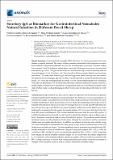Por favor, use este identificador para citar o enlazar a este item:
http://hdl.handle.net/10261/332816COMPARTIR / EXPORTAR:
 SHARE
BASE SHARE
BASE
|
|
| Visualizar otros formatos: MARC | Dublin Core | RDF | ORE | MODS | METS | DIDL | DATACITE | |

| Título: | Secretory IgA as biomarker for gastrointestinal nematodes natural infection in different breed sheep |
Autor: | Castilla Gómez de Agüero, Verónica CSIC ORCID; Valderas García, Elora CSIC ORCID; González del Palacio, Laura CSIC ORCID; Giráldez, Francisco Javier CSIC ORCID ; Balaña-Fouce, R.; Martínez Valladares, María CSIC ORCID CVN | Palabras clave: | GIN Natural infections IgA Biomarker Nasal secretions Protein disulfide isomerase L3 somatic antigen |
Fecha de publicación: | 2023 | Editor: | Multidisciplinary Digital Publishing Institute | Citación: | Animals, 13 (13): 2189 (2023) | Resumen: | Specific IgA antibody has been shown to play an important role in resistance to gastrointestinal nematode (GIN) infections in sheep, particularly in Teladorsagia circumcincta parasitosis. In some breeds, negative associations have been shown between IgA levels and worm burden in experimentally infected sheep. In the present study, we have studied the relationship between IgA levels in naturally infected sheep (582 ewes in total; 193 younger than one year old and 389 older than one year old) and fecal egg count (FEC) in the Assaf, Castellana, and Churra breeds. ELISA assays were performed to measure IgA levels against the somatic antigen of T. circumcincta third larval stage (L3) and a 203-amino-acid fragment of the protein disulfide isomerase from the same GIN species. A multilevel random intercept model was developed to predict the infection risk according to age or breed. Spearman’s correlation rank was used for statistical analysis. The prediction model showed that breed was not an influential factor in this study, although the Assaf breed could be considered slightly more susceptible than the others. In addition, age affected the infection risk, with the young ewes more susceptible to infection than the adult groups, except for the Castellana breed, whose risk of infection was similar at all ages. The most significant positive association was found between FEC and IgA measured in the nasal secretions of young ewes using both antigens (Rho = 0.5; p = 0.00); the correlation of FEC with IgA in serum was moderately significant (Rho = 0.306; p = 0.00). Comparing both antigens, the protein disulfide isomerase antigen was less reactive than the somatic antigen from L3. In conclusion, under natural conditions, specific IgA against GIN was positively associated with FEC in sheep, with nasal secretions from young animals being the sample where this association is stronger, which, therefore, could be used as a marker of infection in further studies. | Descripción: | 13 páginas, 6 tablas, 1 figura. | Versión del editor: | http://dx.doi.org/10.3390/ani13132189 | URI: | http://hdl.handle.net/10261/332816 | E-ISSN: | 2076-2615 |
| Aparece en las colecciones: | (IGM) Artículos |
Ficheros en este ítem:
| Fichero | Descripción | Tamaño | Formato | |
|---|---|---|---|---|
| animals-13-02189.pdf | Artículo principal | 542,8 kB | Adobe PDF |  Visualizar/Abrir |
CORE Recommender
Este item está licenciado bajo una Licencia Creative Commons

